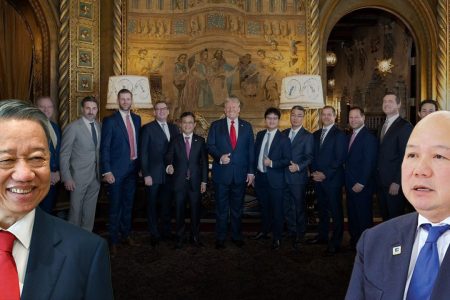
Vietnam is about to enter the new year, the National Assembly has been „optimistic“ to determine the growth rate of gross domestic product (GDP), the most important target in the plan to ensure the legitimacy of the regime, is 6.0 to 6.5% in 2022. Still, the spread of Covid-19 and its negative impact on socio-economic activity pose threats to a fragile recovery.
The situation at home and abroad in the context of the Covid-19 pandemic is so unpredictable that growth scenarios, even those given by reliable forecasting organizations, are difficult to be realized and often have to be adjusted many times. At the beginning of the year, the Central Institute for Economic Management (CIEM) proposed two economic growth scenarios in 2021, which could reach a low of 5.98% and a high of 6.46%. International organizations have also been highly appreciative of Vietnam’s economy, but now they seem to have changed, becoming less „optimistic“ when the Delta, then Omicron variants of the SARS-CoV-virus strain- 2 appeared and spread. At the end of the third quarter of 2021, the Asian Development Bank (ADB) believes that Vietnam’s GDP in 2021 will grow only 3.8%, while the General Statistics Office of Vietnam announced that GDP in the third quarter is estimated to decrease by 6.17% compared to the same period last year, is the deepest decline ever.
First of all, Vietnam’s economy has a large openness, the total import-export turnover compared to GDP is more than 200%, so the recovery will depend on the world economy. Two months ago, most forecasters considered the strong recovery of the world economy in 2022 as a basis, with cooling prices and a shift away from urgent monetary policy. However, the economic situation is still stagnant in the context of political tension and an unpredictable pandemic is an existential risk.
The appearance of the Omicron variant sparked a wave of sell-offs in the world financial markets. Investors are concerned that a new highly infectious virus strain will hinder the world economic recovery. The super variant Omicron is causing many countries, especially in Europe such as the UK, some EU countries, South Korea… to implement stricter blockade orders, causing demand to drop, and supply chains in the world continue to be broken and the number of workers forced to leave the market increases. In addition to the impact of the Omicron variant, the energy crisis, soaring commodity prices, social and geopolitical instability, and climate change are also major threats.
For large markets of Vietnamese goods such as China and the US, there are also problems. Political instability, debt crisis, a wave of real estate bubble burst, and operational difficulties caused by maintaining the Zero-Covid policy in China. The risk of high inflation in the US is threatening the economic recovery, the Federal Reserve (FED) has signaled to cut quantitative easing (QE), this asset purchase program, and raise interest rates. Treasury bonds in 3 times increase in 2022 to restrain at 2.5%. In addition, the economic competition between these two leading world powers has taken on the character of an increasingly intense ideological war that destabilizes the world and Vietnam.
For Vietnam, the lessons for not only forecasters but also policymakers are that the unpredictable Covid-19 pandemic and its impact on economic activity remain the biggest threat to recovery and growth, in which the response strategy and the vaccine strategy are important. Resolution 128 – CP dated October 11, 2021, of the Government, is a landmark policy change, from the policy of “No-Covid” to “living with the pandemic.” Economic losses and a high number of deaths are the direct causes. In Ho Chi Minh City alone, the fourth wave of the epidemic lasted for more than 3 months, causing tens of thousands of deaths, the third quarter’s economy dropped by nearly 7%, and „workers and business households lost VND220 trillion.“ However, the new strategy takes time to assess the impact. In December 2021, the number of Covid-19 infections has always exceeded 10 thousand and is still increasing, the number of deaths has also increased in many localities, some provinces in the South have had to ask for help with medical facilities and human resources. Hanoi has 5 districts with epidemic level 3 (orange) and issued warnings and prepared treatment plans for the number of severe infections to 30,000 hospital beds…
The change of strategy to respond to the pandemic is regaining confidence with investors, especially foreign investors, but it continues to have negative impacts on the socio-economic situation. Normal life was turned upside down on a national scale, the gap between the rich and the poor widened from both poles, the economic structure was broken. Some sectors suffered heavy losses such as tourism, services, airlines, small businesses while a few benefited such as banking, online retail, etc. Economic activity was stagnant due to supply chain disruptions, the stagnation of production activities of enterprises, serious disturbances in the labor market, the price of raw materials are increasing sharply, the cost of epidemic prevention and control… makes goods expensive and demand decreases. In addition, monetary policy is containing high risks in the context of expansion, but the demand for loans for production and business is low, cash flow in the economy is gradually shifting to securities and real estate. Stimulus cash flows are not flowing according to purpose, causing the economy to face the risk of not only high inflation but also asset bubbles like what happened in the 2010s.
Experts say that the Vietnamese economy’s slow recovery compared to the world’s recovery is because „the epidemic crisis in Vietnam has a structural problem, not just a health crisis.“ That is a “U-shaped recovery” with a bottom from the end of 2020 extending into 2021 and continuing into 2022. Many recommendations were made such as continuing income support for affected households to help restore private consumption, supporting small businesses, especially household businesses to help boost economic activities and create jobs while using fiscal policy to boost domestic demand by speeding up the disbursement of public investment… In which, a ‚hot‘ solution is called for the „emergency state„, such as „spending 10% of GDP to fight the epidemic“ or „mobilizing foreign currency or gold in the population” non-market…, is proving that the challenges for economic recovery are very difficult.
The formulation of an economic recovery policy is a problem. The Prime Minister assigned the Ministry of Planning and Investment (MPI) to develop a program for socio-economic recovery and development, emphasizing continuous improvement to report before November 30. However, to date, such a program has not been officially approved. Policy confidence declines not only due to planning but, moreover, to implementation. No matter how ‚good‘ a policy is, being manipulated for profit by corrupted officials will have long-term consequences. The case of Test Kit of Viet A Company is a social tragedy!
Thoibao.de (Translated)
























